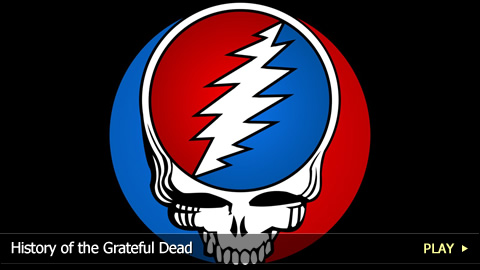History of the Grateful Dead

The Warlocks
Rock band the Grateful Dead formed in Palo Alto, California in 1965 when guitarists and vocalists Jerry Garcia and Bob Weir, keyboardist, harmonica player and vocalist Rob “Pigpen” McKernan, bassist and vocalist Phil Lesh and drummer Bill Kreutzmann first started performing as the Warlocks.
Ken Kesey’s Acid Tests
The band’s longstanding association with psychedelic drugs began early on when they became the house band for author Ken Kesey’s Acid Tests, which were LSD-fuelled parties in the San Francisco Bay Area. After discovering another band called the Warlocks, they became the Grateful Dead and started building on that name by playing free shows.
Debut
Following a short stint with MGM, the Dead released their eponymous LP with Warner Bros. in 1967. However, the blues and psychedelic rock effort received little attention outside San Francisco.
Live Shows
The band then continued developing their live reputation by playing events like the Mantra-Rock Dance, the Monterey Pop Festival and Woodstock. They also added drummer Mickey Hart and keyboardist Tom Constanten to the lineup, while Robert Hunter began making lyrical contributions.
Jamming and Experimentation
Soon, the Dead released the highly ambitious but extremely expensive albums Anthem of the Sun and Aoxomoxoa. These records showcased their fondness for jamming and experimentation, as well as a psychedelic sound that spanned pop, rock, folk, blues and country.
Live Albums
The band’s talent for improvisations and varied song interpretations was best captured on their multiple live compilations and the recordings taped by Deadheads throughout the years. 1969’s Live/Dead was considered one of their absolute best.
Chart Success
Though a drug bust in early 1970 put a damper on things, the Dead found chart success when Workingman’s Dead and American Beauty charted within the top thirty that same year.
Line-up Changes
The Grateful Dead soon added keyboardist Keith Godchaux and backup vocalist Donna Jean Godchaux to the team, while John Perry Barlow started writing lyrics. And, despite Pigpen’s alcohol-related death in 1973, the Dead marched on.
Commercial Success
After the colossal Summer Jam at Watkins Glen festival, they finally found commercial success through their own label with the jazz-tinged Wake of the Flood and the acid rock-based From the Mars Hotel. They also distinguished themselves by using their massive Wall of Sound audio system during live performances.
Hiatus and Other Projects
Mid-decade, The Grateful Dead went on a two-year hiatus while members concentrated on side projects, though the studio LP Blues for Allah was released in 1975.
More Music and Line-up Changes
They resumed touring the following year and in 1977 they dropped the more symphonic and less freeform studio album, Terrapin Station, via Arista Records. Late in the decade, Keith and Donna Jean Godchaux were replaced by keyboardist Brent Mydland.
Touring
Following 1978’s Shakedown Street, the Grateful Dead only came out with one studio album in the early 1980s: Go to Heaven. Though a few live compilations were released, the band instead concentrated on touring.
Top Ten Hit
After a health scare forced Garcia to curb his drug use, their next studio album was only unveiled in 1987 – but it was worth the wait: In the Dark became the band’s first and only top ten effort, and spawned their highest charting single: the top ten track, “Touch of Grey.”
Last Album
Reinvigorated by this success, the Dead were as present as ever on the touring circuit. Unfortunately, 1989’s Built to Last was the group’s final studio record; the next year, Mydland died from a drug overdose. With keyboardist Vince Welnick and pianist Bruce Hornsby as his replacements, the band slowly got back on the road.
Jerry Garcia’s Death
After another health scare in 1992, Garcia died of a heart attack while in drug rehab three years later.
Musical Legacy
Though originally categorized as psychedelic rockers, the Grateful Dead essentially spearheaded the jam band. By bringing thousands of Deadheads together through their unique musical style and transcendental live shows, the Grateful Dead altered the history of rock music for the better.
